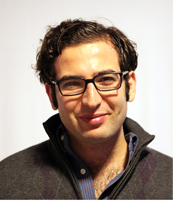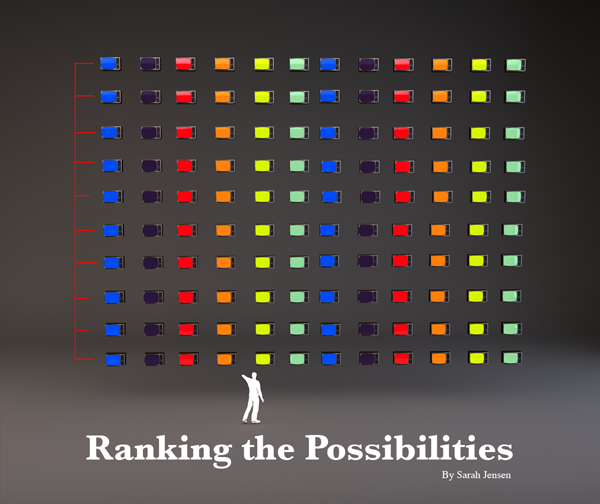From earliest childhood, Ammar Ammar was fascinated by all things electronic and mechanical: cameras, radios, household gadgets, and appliances. "I took apart most of the small clocks in our house to try and see what made them tick," he recalls.
Ammar's mother and his father—an English professor in the Palestinian town where he grew up—championed his curiosity and encouraged him to explore the extensive library in their home. "My father answered the easy questions with anecdotes and the hard ones by pointing to his bookshelves," says Ammar. When he was 6, Ammar was introduced to computers, and after a few years enjoying video games, he had the chance to write his first computer program, a trigonometric calculator, in the C programming language. Later, he designed a program that controlled lights through the printer port. "For the first time," he says, "I realized that a passing thought could come to life through creating a program. It felt like magic."
When he was in high school, Ammar's mentor, a family friend from Wales who lived nearby, introduced him to the work of philosopher and mathematician Bertrand Russell. "She was inspired by him in college," he says, "and she encouraged me to read his works. I started with his beautifully written autobiography and some of his popular essays, and found myself slowly drawn to his more abstract work. His discussion of the problem of induction set me thinking seriously about such concepts."
In 2005, Ammar followed his passions to MIT where he discovered a community equally inquisitive about how things work. A first-year probability course introduced him to Devavrat Shah, Jamieson Associate Professor in MIT's Electrical Engineering and Computer Science department, who is based in LIDS. "I think I asked too many questions in that class," says Ammar. "And Dr. Shah's answers intrigued me." Shah impressed upon Ammar the idea of research as a willingness to explore in the face of the unknown. "He taught me that there is always uncertainty at the outset, but we mustn't put limits on our potential or the possibilities of what we might accomplish," says Ammar.
Ammar received his undergraduate degree in computer science and electrical engineering in 2009, and still eager to face those unknowns, joined LIDS in his pursuit of a PhD in computer science. In his second year, he teamed with fellow student Srikanth Jagabathula, Sloan School associate professor Vivek Farias, and Shah, now his PhD advisor, to begin their innovative work on recommendation systems, the technology used on websites from Amazon to eBay to Yelp to help users identify the books and movies and restaurants they seek. "People are asked to make choices all the time," says Ammar, "and we felt the better we could make our recommendation systems, the faster people would be able to find exactly what they're looking for and facilitate their decisions."
Existing recommendation systems, Ammar and his team soon found, are seriously flawed. Relying as they do on a subjective scale—five stars for excellent, say, and one for poor—their results are a bit murky. One rater's interpretation of three stars may not be the same as another's. And individuals may rate the same item differently from one day to the next depending on their mood, leading to noisy data and oftentimes inaccurate recommendations.
A better way to capture customer sentiment, they realized, is through rankings, in which items are compared with each other rather than assigned individual scores. Ammar and his team set about creating a framework and a number of algorithms that accomplish just that, resulting in more precise and objective data. In 2011, they demonstrated that their approach is able—using a year's worth of data on automobile sales—to predict preferences with 20 percent greater accuracy than existing algorithms.
The comparison method yields rich, accurate information, but the complex computation required to extract data from across all options and customer profiles is a challenge: As more choices are introduced, the number of possible customer profiles grows exponentially. "If we ask people to compare coffee and tea, the result is two profiles: those who prefer coffee and those who prefer tea," explains Ammar. "But if we add hot chocolate, there are six possible orderings." Comparing four items yields 24 profiles, and if 10 items are compared, the rankings can be ordered in more than three million configurations.
That's a lot of possibilities, and the team took one step back to realign their perspective. "We believed that fewer possible profiles actually exist in a population," says Ammar. "And we realized it wasn't necessary to explicitly keep track of all them." Rather than tackle the dizzying task of analyzing millions of profiles, they discovered the data could be summarized—and yield the same robust results. Currently, they're exploring ways to increase the resolution of that process through an algorithm that views the larger population as a collection of smaller populations. Narrowing the entire restaurant-going public to groups with shared taste profiles, for instance, would add a granularity to the rankings and enable potential consumers to more easily make choices based on the information provided by others in their subgroup.
Internet shoppers are another group that can benefit from the ranking system. The proliferation of online retailers has made Internet shopping more difficult than visiting a brick and mortar store, says Ammar. "It takes time to search online in a brute force way to find the exact item you want." Locating the perfect shirt, for example, could involve navigating among a dozen sites and sharing links with friends to gather their opinions—and could take hours. Further refinements to the group's algorithm could streamline the virtual shopping experience, allowing customers to more quickly and accurately narrow their search and locate the ideal item based on price, style, and color—with only a few clicks of the mouse.
Ammar has begun work on additional practical applications of the technology, including gathering student preference information in order to place them in the class section most appropriate and convenient to them. Another potential application is a polling system to collect preferences of students and faculty, resulting in the ability to recommend activities, locations, and times that best match their leisure interests and schedules—and reserve a spot in their favorite section of the venue. Ammar's work isn't likely to stop there. He plans to spend the summer at Microsoft Research in Seattle investigating further possibilities in the area of public opinion polling.
He may step away from the lab from time to time and bring out glue and leather and indulge in his longtime avocation of vintage bookbinding, or join friends in a relaxing sail up the Charles River. But Ammar's greatest satisfaction, he says in a nod to physicist Richard Feynman, is the pleasure of finding things out. "I may approach a problem knowing very little," he says. "It may not be clear in the beginning where a project will lead, but slowly, it begins to unfold." He gives no little credit for his success to his LIDS colleagues and mentors. "In the LIDS community, we have the opportunity to share different perspectives, and that always helps clarify the challenges inherent in research," he says. "Good ideas are always realized in collaboration."




